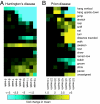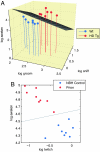The power of automated high-resolution behavior analysis revealed by its application to mouse models of Huntington's and prion diseases
- PMID: 17261803
- PMCID: PMC1794260
- DOI: 10.1073/pnas.0610779104
The power of automated high-resolution behavior analysis revealed by its application to mouse models of Huntington's and prion diseases
Abstract
Automated analysis of mouse behavior will be vital for elucidating the genetic determinants of behavior, for comprehensive analysis of human disease models, and for assessing the efficacy of various therapeutic strategies and their unexpected side effects. We describe a video-based behavior-recognition technology to analyze home-cage behaviors and demonstrate its power by discovering previously unrecognized features of two already extensively characterized mouse models of neurodegenerative disease. The severe motor abnormalities in Huntington's disease mice manifested in our analysis by decreased hanging, jumping, stretching, and rearing. Surprisingly, behaviors such as resting and grooming were also affected. Unexpectedly, mice with infectious prion disease showed profound increases in activity at disease onset: rearing increased 2.5-fold, walking 10-fold and jumping 30-fold. Strikingly, distinct behaviors were altered specifically during day or night hours. We devised a systems approach for multiple-parameter phenotypic characterization and applied it to defining disease onset robustly and at early time points.
Conflict of interest statement
Conflict of interest statement: A.D.S., W.S.J., O.D.K., and S.L. initially purchased HCS and received an additional software license in exchange for assistance with further refinement of the program. None of the authors have received remuneration from Clever Systems, Inc. as a stockholder, consultant, or employee.
Figures




References
Publication types
MeSH terms
LinkOut - more resources
Full Text Sources
Other Literature Sources
Medical
Molecular Biology Databases

